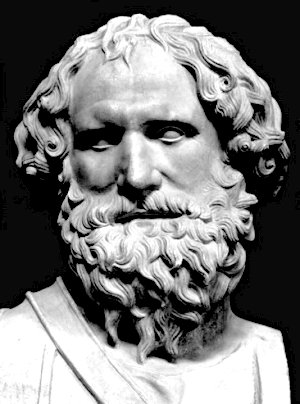

And he made a molten sea, ten cubits from the one brim to the
other;
it was round all about ... and a line ot thirty cubits did
compass it round about.
The constant p (Greek
letter pi) is, classically, defined as the ratio of the
circumference p of a circle to its diameter d:
and, as proved by Archimedes of Syracuse (287-212 BC) in his famous Measurement of a Circle, the same constant is also the ratio of the area A enclosed by the circle to the square of its radius r:
|

Archimedes |
In 1934, the German mathematician Edmund Landau
(1877-1938) gave a new and analytical definition based
on the cosine function
Obviously cos 0 = 1 and cos 2 < -1/3 (take the 3 first
terms of the sequence), from the continuity of the cosine function, the
equation cos t = 0 has roots. If t1is the
smallest positive root of this equation, p is
defined as 2t1 [3]. Several variants based on similar trigonometric
equations are also possible. |

cosine function |
The first use of the symbol p to represent the ratio
of the circumference to the diameter is given in Synopsis Palmariorum
Mathseos by the Welsh mathematician William Jones (1675-1749) in 1706. It
was probably inspired by the greek word for circumference: perijeria (peripheria). Later and progressively, this
notation was popularized in his publications by the Swiss Leonhard Euler
(1707-1783) [1].
p is also known as
Archimedes' constant or Ludolph's number.
| In 1761, Johann Heinrich Lambert (1728-1777) was
the first to prove that the number p is an
irrational number [4]. Adrien-Marie Legendre (1752-1833) also proved, in
1794, that p2 is irrational. It was not before the year 1882 that Ferdinand von Lindemann (1852-1939) succeeded to prove that p is a transcendental number [5] and therefore is not the root of any integer polynomials. With this last result, it was consequently established that the famous and old problem of squaring the circle with a ruler and a compass is insoluble. |
|
|
A simplified proof of the irrationality of p can be found in Irrationality proofs.
 van Ceulen restored tombstone |
The history of the constant p is often divided into periods. The first period, or
geometric period, began long ago with the Egyptians, Babylonians
and Greeks determinations of the ratio of the circumference to its
diameter and extended up to the beginning of the seventeenth century with
Ludolph van Ceulen (1540-1610) 35 decimal places great calculation. It was
the period of the geometricians and polygons computations. The geometric period The second period, or classic period, was
the time of analytical developments, many infinite series or products were
discovered to compute p. It started, around 1650,
with the works of John Wallis (1616-1703), William Brouncker (1620-1684),
James Gregory (1638-1675), Isaac Newton (1643-1727) and went up to the
first electronic computation of p. A special
chapter is devoted to the Indian mathematician Srinivasa Ramanujan
(1887-1920) who found extraordinary series at the beginning of the
twentieth century. The third period is recent and started around
1970 with the work of Richard Brent and Eugène Salamin who used previous
results by Gauss and Legendre on the Arithmetic-Geometric Mean
(AGM) to find a new kind of expression for p.
Other similar results, discovered by Jonathan and Peter Borwein, made the
computation of billions digits of p
reachable. |